Do you have a question about the Mercury 300XS OptiMax and is the answer not in the manual?
How to register your Mercury outboard in the US and Canada.
Process for transferring the limited warranty to a new owner.
Details the 2-year warranty for Mercury Racing OptiMax XS outboards.
Information on warranty for products sold to government agencies.
Covers corrosion damage for 3 years on specific engine models.
Explains what is and isn't covered under Mercury Racing outboard warranties.
Details warranty for emission control systems in California for certain model years.
Explains the meaning of different star labels for cleaner marine engines.
Outlines the operator's duties for safe boat and outboard operation.
Advises reading the manual and understanding operation before use.
Warns against exceeding the boat's maximum horsepower limit.
Provides guidance for operating high-speed or high-performance boats.
Discusses requirements for remote control systems, including start-in-neutral.
Emphasizes using self-locking nuts for steering link rod fasteners.
Explains the function of the lanyard stop switch for safety.
Provides safety advice for operating a boat when people are in the water.
Alerts users to the dangers of carbon monoxide poisoning from exhaust fumes.
Safety instructions specific to pontoon and deck boats regarding passenger seating.
Discusses hazards associated with jumping waves or wakes.
Advises caution and speed control when operating in areas with potential underwater obstacles.
Guidance on choosing and installing accessories for the outboard.
Offers general advice for safe boating practices.
Importance of recording engine serial number for future reference.
Lists detailed specifications for the 300XS OptiMax model.
Lists special tools and kits recommended for servicing the outboard.
Illustrates and labels key components of the outboard motor.
Guidance on choosing the correct propeller for optimal performance and engine protection.
Instructions and precautions for trailering the boat and outboard.
Warnings about components that can restrict fuel flow and cause engine damage.
Specifies the type of fuel and octane requirements for the engine.
Details the recommended type of 2-cycle oil for the outboard.
Instructions for filling the remote oil tank.
Procedures for filling the engine-mounted oil reservoir tank.
Safety precautions and steps for filling the fuel tank.
Explains the functions of various Mercury Precision and Quicksilver remote controls.
Details the features of the Zero Effort control system.
Describes the boat's warning horn system and signals.
Explains the engine's guardian system for monitoring and protecting the engine.
How the engine's overspeed protection system works and how to reset it.
Explains the function and operation of the power trim and tilt system.
Details how to operate the power trim system for optimal performance and safety.
Discusses methods for limiting trim-in to ensure safe handling.
Instructions for operating the power tilt on single-ram systems.
Instructions for operating the power tilt on three-ram trim systems.
Explains the use of the auxiliary tilt switch for adjusting outboard position.
Procedures for manually tilting the outboard if power tilt fails.
Procedures and warnings for breaking in the new engine to ensure proper operation.
Specific instructions regarding fuel mixture during engine break-in.
Essential checks to perform before starting the outboard engine.
Notes on water discharge characteristics at off-idle speeds.
Important precautions for operating the outboard in freezing conditions.
Recommendations for flushing the outboard after use in salt or polluted water.
How engine performance is affected by high elevations.
Explains how environmental factors impact engine performance.
Guidance on setting trim angle at idle to avoid issues like exhaust restriction.
Procedures for operating the outboard in shallow water to avoid damage.
Step-by-step instructions for starting the outboard engine safely.
Instructions for shifting gears safely and correctly.
Procedures for safely stopping the outboard engine.
General advice for maintaining the outboard's power package for longevity.
Immediate service requirements for a submerged outboard.
Recommends using genuine Mercury Precision replacement parts.
Explains Mercury's compliance with EPA emissions regulations and servicing.
Describes the emission certification label found on the engine.
Outlines the owner's responsibilities for maintaining emission levels.
Provides a schedule for routine inspections and maintenance tasks.
Instructions for flushing the powerhead's cooling system with fresh water.
Instructions for flushing the lower unit's cooling system.
Procedures for removing and installing the outboard's top cowl.
Guidance on cleaning and waxing the outboard's top cowl.
General information about the outboard's fuel system.
How to inspect fuel lines and primer bulbs for wear or damage.
Explains the function of the water-separating fuel filter and its maintenance.
Procedures for draining accumulated water from the fuel filter chamber.
Important instructions regarding steering link rod fasteners and safety warnings.
Information on fuse identification, replacement, and carrying spares.
Explains the function of anodes and their inspection/replacement.
Step-by-step guide for inspecting and replacing spark plugs.
How to inspect the battery for proper engine starting capability.
Describes the function of the charging system's fusible link.
Step-by-step instructions for removing the propeller.
Step-by-step instructions for installing the propeller.
Identifies specific points on the outboard that require lubrication.
How to check and refill power trim fluid for single-ram systems.
How to check and refill power trim fluid for three-ram systems.
Procedures for checking and refilling gearcase lubricant.
Instructions for draining the gearcase lubricant.
Steps to prepare the outboard for out-of-season or prolonged storage.
Guidelines for storing the boat battery properly.
Possible causes and solutions when the starter motor doesn't crank the engine.
Common reasons why the engine fails to start and troubleshooting steps.
Identifies potential causes for the engine running erratically.
Lists common reasons for a loss of outboard performance.
Explains causes for the warning horn sounding when power is lost.
Explains causes for the warning horn sounding without power loss.
Troubleshooting steps for a battery that won't hold a charge.
Explains normal water discharge from the idle exhaust during operation.
Recommends using local authorized dealers for service.
Advice for obtaining service when away from your local dealer.
Where to direct inquiries about replacement parts and accessories.
Steps to take if unable to resolve issues with a dealership.
Contact information for Mercury Marine service offices worldwide.
Information required to order additional literature for your power package.
| Engine Type | 2-Stroke |
|---|---|
| Horsepower | 300 HP |
| Alternator Output | 60 amp / 756 watt |
| Gear Ratio | 1.75:1 |
| Starting System | Electric |
| Fuel System | 2-Stage Direct Fuel Injection (DFI) |
| Weight | 505 lbs / 229 kg |
| Cylinders | 6 |
| Steering | Hydraulic |
| Shaft Length | 25" |
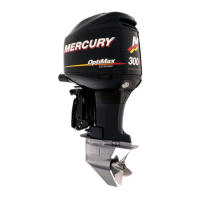
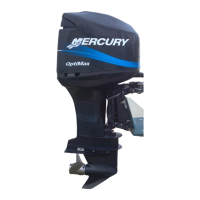
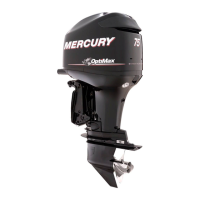
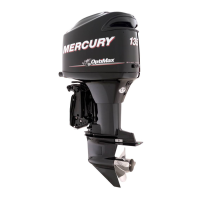
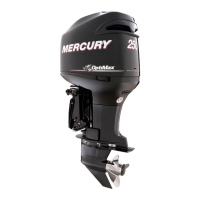

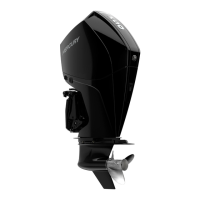
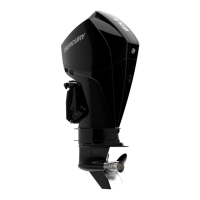
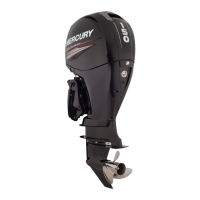
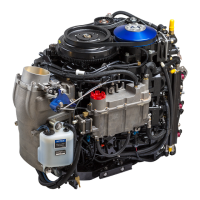

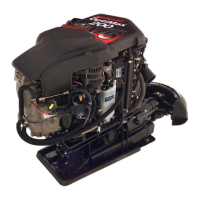
